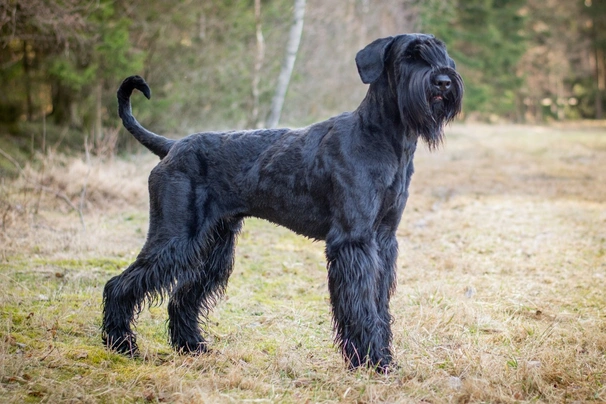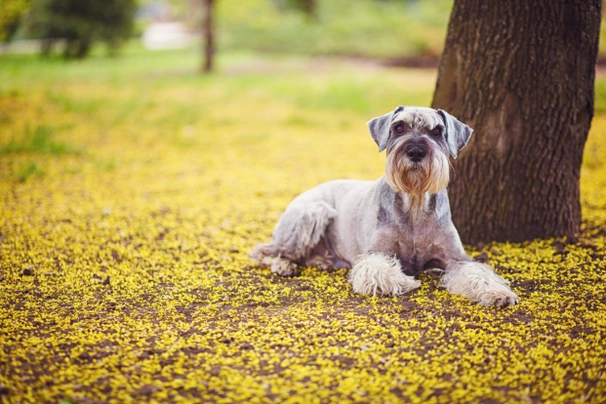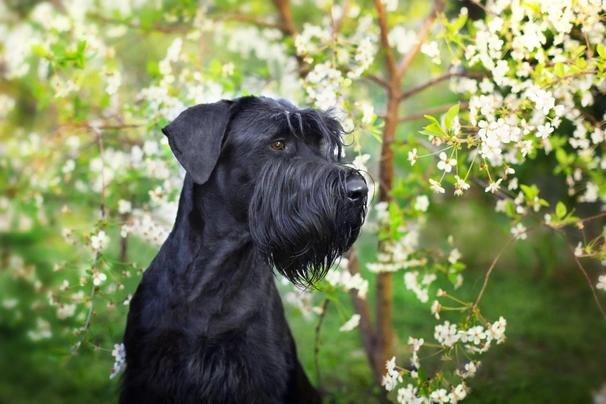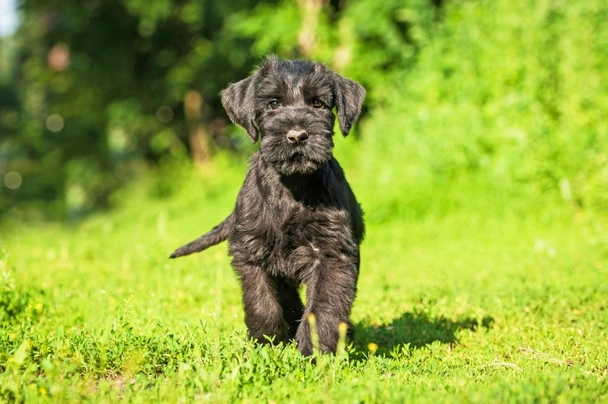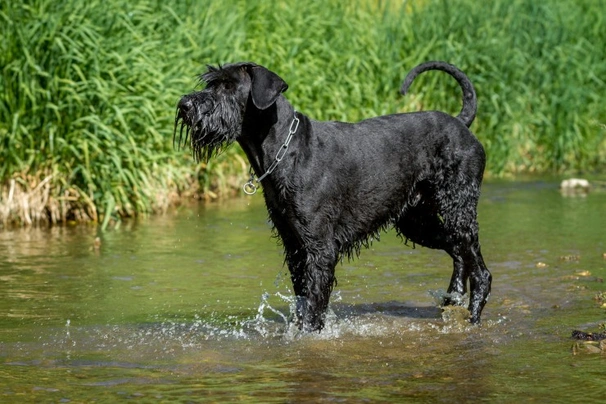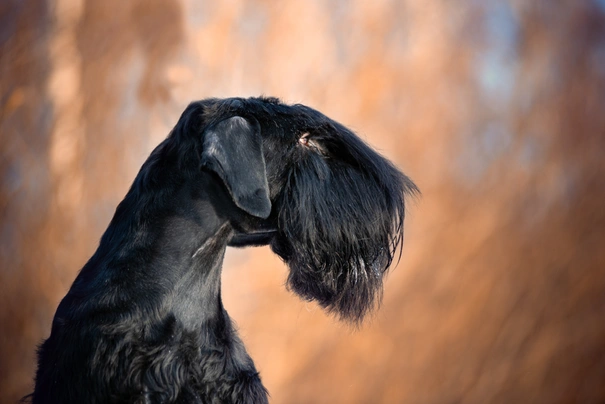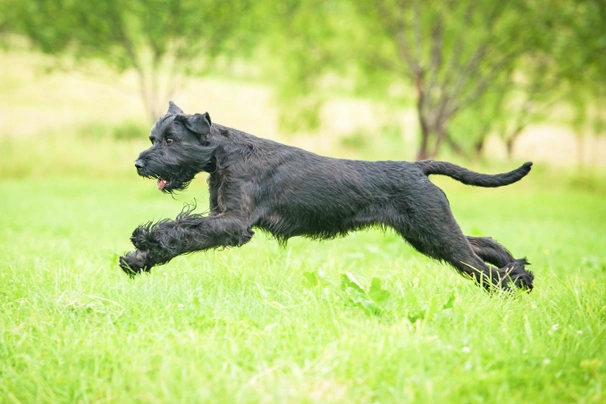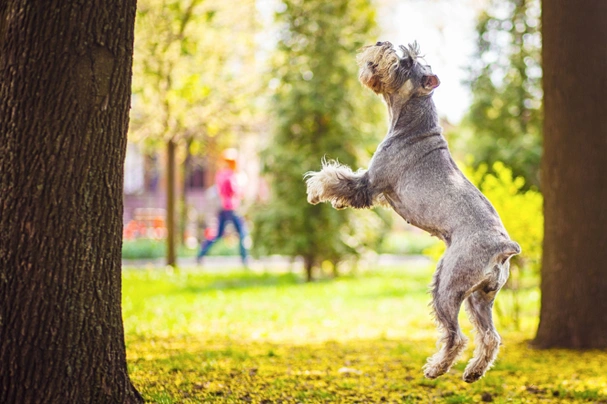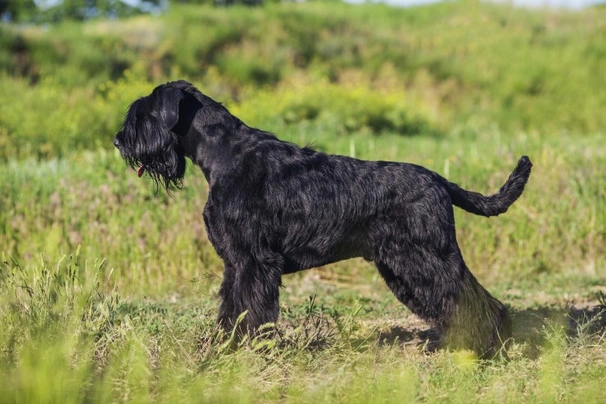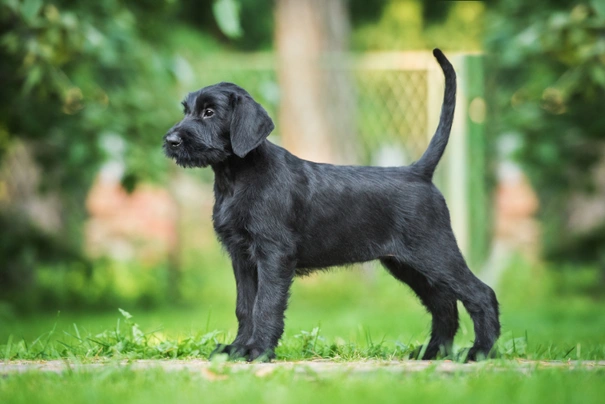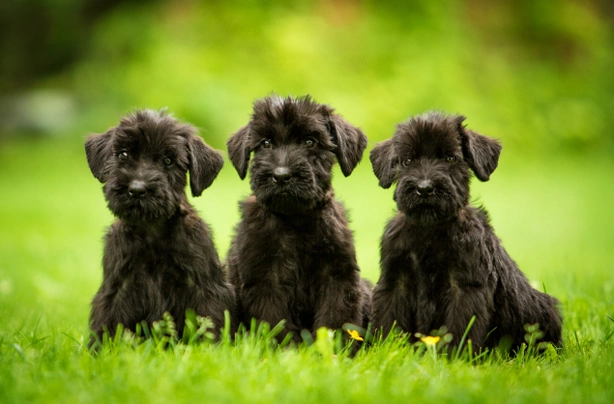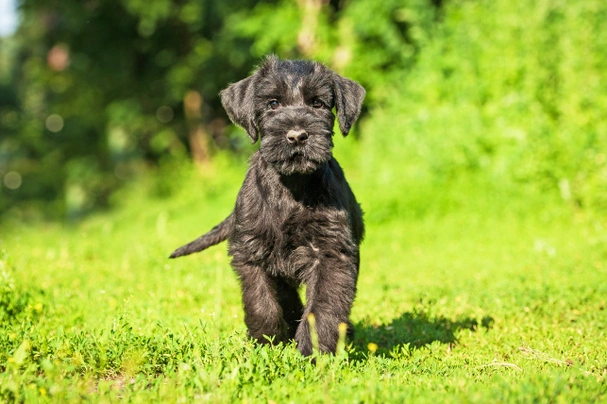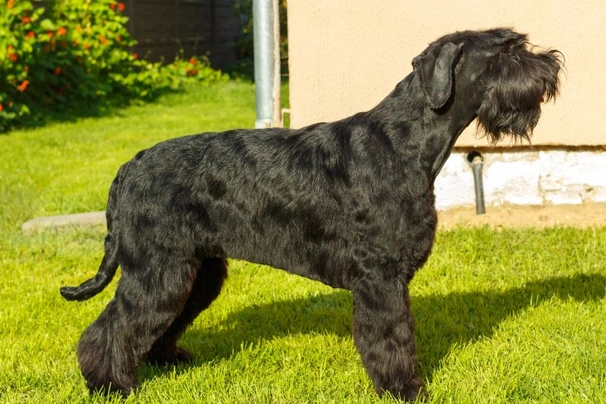Giant Schnauzer
Pros
Cons
Introduction of the Giant Schnauzer
Giant Schnauzers are powerful looking dogs with an imposing air about them and they are known as a "groomed breed" because they have high maintenance coats which need to be hand stripped several times a year. They are the epitome of agility strength and unique looks which are just some of the reasons why the breed has become so popular with people all over the world. But it's not just their charming looks that get these dogs noticed because they boast wonderful personalities and rarely would a Giant Schnauzer display any sort of aggressive behaviour unless they feel threatened that is.
These distinct looking dogs are better suited to people who are familiar with the specific needs of such a large dog and realise the cost involved and who understand that Giant Schnauzers need lots of daily physical exercise not to mention their grooming needs which are to say the least substantial.
History of the Giant Schnauzer
The Giant Schnauzer has been around for centuries and were used in their native Germany by farmers on cattle drives. As such they were always highly prized herding dogs. For a while the popularity of the breed diminished thanks to the fact Giant Schnauzers were no longer needed to drive cattle when the railways took over this task. However they proved to be a hit with people in towns and cities where these large dogs were given a different job which was one of a guard dog. Giant Schnauzers were even used as mascots for both butcher shops and beer halls. Later early in the twentieth century they became a preferred breed used by many police forces across Europe. In their native Germany they are called Riesenschnauzers which translated means "snout".
It was not until the early sixties that the first Giant Schnauzer was seen in the UK joining the Miniature and the Standard Schnauzer but it was only 10 years later in the seventies that the breed finally made its mark in the dog world. Over time these larger than life dogs have been developed into intelligent bold reliable and nice natured characters that are not only popular as a companions and family pets but also as therapy dogs helping the police in their work they are used as search and rescue dogs as well as doing valuable work as sniffer dogs.
Interesting facts about the breed
- Is the Giant Schnauzer a vulnerable breed? No they have consistently remained a popular family pet and companion both in the UK and elsewhere in the world
- Giant Schnauzers are known to be good gundogs as well as herding dogs
- The breed has also been highly prized working alongside the military and police in their native Germany
- Traditionally a Giant Schnauzer's tail was always docked but since the law banning the procedure came into effect in 2007 tail docking is now illegal with the exception being for some working breeds and if a dog suffers from some sort of health issue that requires their tails to be docked. The procedure must be agreed and authorised by the correct department before being performed by a qualified vet
Appearance of the Giant Schnauzer
Height at the withers: Males 65 - 70 cm Females 60 - 65 cm
Average weight: Males 34 - 43 kg Females 34 - 43 kg
Giant Schnauzers are impressive looking dogs known as a "groomed" breed because they are high maintenance when it comes to keeping their coats looking as they should. The reason they need more in the way of coat care is because they don’t cast it or shed hair like other breeds. The other thing to bear in mind is that once a Giant Schnauzer's beard has grown to its full length it will get soaked every time a dog has a drink of water and it gets pretty messy when they eat too.
Although large the Giant Schnauzer is an athletic looking dog they are extremely agile well-muscled and they need to be given a lot of exercise to keep them fit and healthy. They boast strong heads with a medium stop that’s accentuated by a dog's bushy eyebrows. Their muzzles are powerful looking with whiskers under the chin and dogs boast a stubbly moustache too. Nose is black with nice wide nostrils.
A Giant Schnauzer's eyes are set forward oval-shaped and medium in size and their ears are set high on a dog's head being a neat V shape and dropping forward. Their jaws are strong with dogs boasting a perfect scissor bite where their upper teeth neatly overlap their lower ones. Lips are black and tight. They boast a moderately long neck that dog's hold slightly arched and it is set very cleanly on their shoulders.
Shoulders are well laid back and flat with dogs having nice straight well-muscled front legs with lots of bone right down to their feet. Their chest is quite deep and broad with a nice strong straight back which is slightly lower at the croup than it is at the shoulder. Their ribs are well sprung and loins slope slightly. Hindquarters are strong and well-muscled with dogs boasting strong upper thighs and back legs. Their feet point forward and are compact with well arched toes and dark firm paw pads with dark nails. Their tails are set high which dogs carry at an angle just above their topline.
When it comes to their coat the Giant Schnauzer has a wiry harsh top coat and a good undercoat. The hair on their neck and shoulder is slightly shorter but it blends in well with the rest of a dog's body. The hair on their legs is harsher to the touch. Giant Schnauzers come in two colour types which are acceptable for Kennel Club registration which are as follows:
- Black
- Pepper & Salt - accepted shades from a dark iron grey to a light grey
Dogs have dark facial masks that go with their coat colour which adds to their good looks and overall appeal.
Gait/movement
When a Giant Schnauzer moves they do so with a free well-balanced gait showing tremendous reach in their forequarters and drive coming from their hindquarters. When a dog moves they keep their toplines nice and level whether walking or at faster paces.
Faults
The Kennel Club frowns on any exaggerations or departures from the breed standard and would judge the faults on how much they affect a dog's overall health and wellbeing as well as their ability to perform.
Males should have both testicles fully descended into their scrotums and it is worth noting that a dog can be a little lighter or heavier as well as slightly taller or shorter than set out in the Kennel Club breed standard which is given as a guideline only.
Temperament of the Giant Schnauzer
Giant Schnauzers are known for their good natures and their calmness. They have a natural ability to protect and guard their owners and their property which sees them become valued members of a family. These big dogs like to be involved in everything that goes on in a household and if left to their own devices they quickly become bored which can result in them becoming unruly and hard to handle. They are not however the best choice for families with young children.
Giant Schnauzers mature very late which means sharing a home with one of them can be challenging for the first 12 months or so. They are often likened to living with difficult adolescent teenagers. Then there's the cost of keeping one of these large dogs which is that much higher than many other breeds thanks to the cost of having them professionally groomed several times a year.
Are they a good choice for first time owners?
Giant Schnauzers are not the best choice for first time dog owners because they are better suited to people who are familiar with the needs of such a large intelligent and high-energy dog.
What about prey drive?
Giant Schnauzers have a high prey drive which means care should always be taken as to where and when they can run off the lead which is especially true if they are near livestock and wildlife. Introductions to new animals and pets must be done slowly and carefully to make sure things go smoothly.
What about playfulness?
Schnauzers have a very playful side to their natures and love to entertain and be entertained. They are known to be a little mischievous and quickly learn what pleases an owner and being smart Giant Schnauzers also learn how to get their own way. They love playing interactive games and take part in lots of canine sports which includes activities like agility.
What about adaptability?
Giant Schnauzers are large dogs without being massive but they still need enough space to express themselves. As such they are much better suited to households with back gardens rather than apartments so that a dog can safely roam around an outdoor area as often as possible.
What about separation anxiety?
Giant Schnauzers are not especially fond of spending too much time on their own although they do not typically suffer from separation anxiety. However if they do find themselves alone for too long they quickly get bored and will develop some unwanted behaviours which includes being unruly destructive and even harder to control.
What about excessive barking?
Giant Schnauzers are not known to be "barkers" but this is not to say that they are not quick off the mark to let an owner know when there are strangers about or when something they don't like is going on in their surroundings.
Do Giant Schnauzers like water?
Most Schnauzer love swimming and will take to the water whenever they can more especially when the weather is hot. However if anyone who owns a dog that does not like water should never force them to go in because it would just end up scaring them. With this said care should always be taken when walking a dog off the lead anywhere near more dangerous watercourses just in case a dog decides to leap in and then needs rescuing because they cannot get out of the water on their own. It is also essential for them to thoroughly dried off to avoid any moisture being trapped in their coats which could lead to a skin allergy flaring up.
Are Giant Schnauzers good watchdogs?
Giant Schnauzers are natural watchdogs because it is in their DNA to guard and protect. As such they don't need to be taught to guard which could end up making them more dominant and therefore harder to control and live with.
Intelligence / Trainability of the Giant Schnauzer
Giant Schnauzers are highly intelligent but they have a bit of a stubborn streak which many experts believe is because these dogs are so smart. With this said in the right hands and with the correct amount of training a Giant Schnauzer usually excels at things they are taught to do. If there is one thing these large dogs like it's learning new things and enjoy taking part in canine activities like agility and obedience but they need to know who is boss.
Children and other
Giant Schnauzers instinctively protect their owners and their property making them loyal and extremely good watchdogs. They do however need to be taught their place in the pack and who is alpha dog in the household which is particularly important when they live with families with children. They are not the best choice of dog for people with younger children because of their strong instinct to guard.
Male dogs tend to be a little bit more unpredictable when they are around other male dogs and Giant Schnauzers are not good around cats and other small pets commonly found in the home so care must be taken when these dogs meet them.
Giant Schnauzer puppies are very cute and it is all too easy to spoil them when they first arrive in their new homes. However owners should start out as they mean to go on which means laying down rules and boundaries so that puppies understand what is expected of them. Naturally a playful puppy will always test these from time to time but it is important to stay consistent so they learn what is acceptable behaviour and what is not. It is also a good idea to teach a puppy that playtime takes place outdoors to avoid any breakages around the home as they get bigger bearing in mind that Giant Schnauzers go through a boisterous "adolescent" stage when they are around 12 months old. With this said the first commands a puppy should be taught are as follows:
- Come
- Sit
- Stay
- Heel
- Quiet
- Leave it
- Down
- Bed
Health of the Giant Schnauzer
The average life expectancy of a Giant Schnauzer is between 10 and 12 years when properly cared for and fed an appropriate good quality diet to suit their ages.
Giant Schnauzers are known to be a healthy and robust breed but they do suffer from a few hereditary disorders which are worth knowing about if you are hoping to share your home with one of these lively large dogs. The health issues that seem to affect the breed the most includes the following:
- Progressive retinal atrophy (PRA) - dogs should be tested through the BVA/KC eye scheme
- Hereditary cataracts (HC) - dogs and bitches should have a "clear" eye certificate that is less than 12 months old
- Multi-focal Retinal Dysplasia (MRD) - Puppies should be screened for MRD before leaving their breeder and going to a new home
- Hip dysplasia - dogs should be hip scored
- Epilepsy
- Hypothyroid
- Canine melanomas - skin toe and mouth
- Bloat/gastric torsion
What about vaccinations?
Giant Schnauzer puppies would have been given their initial vaccinations before being sold but it is up to their new owners to make sure they have their follow-up shots in a timely manner with the vaccination schedule for puppies being as follows:
- 10 -12 weeks old bearing in mind that a puppy would not have full protection straight away but would be fully protected 2 weeks after they have had their second vaccination
There has been a lot of discussion about the need for dogs to have boosters. As such it's best to talk to a vet before making a final decision on whether a dog should continue to have annual vaccinations which are known as boosters.
What about spaying and neutering?
A lot of vets these days recommend waiting until dogs are slightly older before spaying and neutering them which means they are more mature before undergoing the procedures. As such they advise neutering males and spaying females when they are between the ages of 6 to 9 months old and sometimes even when a dog is 12 months old.
Other vets recommend spaying and neutering dogs when they are 6 months old but never any earlier unless for medical reasons. With this said many breeds are different and it is always advisable to discuss things with a vet and then follow their advice on when a dog should be spayed or neutered.
What about obesity problems?
Some Giant Schnauzers can gain weight after they have been spayed or neutered and it's important to keep an eye on a dog's waistline just in case they do. If a dog starts to put on weight it's important to adjust their daily calorie intake and to up the amount of exercise they are given. Older dogs too are more prone to gaining weight and again it's essential they be fed and exercised accordingly because obesity can shorten a dog's life by several years. The reason being that it puts a lot of extra strain on a dog's internal organs including the heart which could prove fatal.
What about allergies?
Some Giant Schnauzers are prone to suffering from allergies and it's important for a dog to see a vet sooner rather than later if one flares up. Allergies can be notoriously hard to clear up and finding the triggers can be challenging. With this said a vet would be able to make a dog with an allergy more comfortable while they try to find out the triggers which could include the following:
- Certain dog foods that contain high levels of cereal and other grain fillers
- Airborne pollens
- Dust mites
- Environment
- Flea and tick bites
- Chemicals found in everyday household cleaning products
Participating in health schemes
All responsible Giant Schnauzer breeders would ensure that their stud dogs are tested for known hereditary and congenital health issues known to affect the breed by using the following schemes:
- BVA/KC/ISDS Eye Scheme
- BVA/KC Hip Dysplasia Scheme
- BVA/KC/ISDS Eye Scheme (litter screening) - puppies need to be eye screened for Multi-focal retinal dysplasia (MRD) when they are 6 to 12 weeks old and before they are sold to new owners
What about breed specific breeding restrictions?
Apart from the standard breeding restrictions for all Kennel Club registered breeds there are no other breed specific breeding restrictions for the Giant Schnauzer.
What about Assured Breeder Requirements?
It is mandatory for all Kennel Club Assured breeders to use the following tests and the Kennel Club strongly recommends that all other breeders follow suit:
The Kennel Club also recommends that all breeders use the following tests:
Caring for the Giant Schnauzer
As with any other breed Giant Schnauzers need to be groomed on a regular basis to make sure their coats and skin are kept in top condition. They also need to be given regular daily exercise to ensure they remain fit and healthy. On top of this they need to be fed good quality food that meets all their nutritional needs throughout their lives.
Caring for a Giant Schnauzer puppy
Giant Schnauzer puppies are boisterous and full of life which means it's essential for homes and gardens to be puppy-proofed well in advance of their arrival. A responsible breeder would have well socialised their puppies which always leads to more outgoing confident and friendly dogs right from the word go. With this said any puppy is going to feel vulnerable when they leave their mother and littermates which must be taken into account. The longer a puppy can remain with their mother the better although it should never be for too long either.
It's best to pick a puppy up when people are going to be around for the first week or so which is the time needed for a puppy to settle in. Puppy-proofing the home and garden means putting away any tools and other implements that a boisterous puppy might injure themselves on. Electric wires and cables must be put out of their reach because puppies love chewing on things. Toxic plants should be removed from flowerbeds and the home too.
Puppies need to sleep a lot to grow and develop as they should which means setting up a quiet area that's not too out of the way means they can retreat to it when they want to nap and it's important not to disturb them when they are sleeping. It's also a good idea to keep "playtime" nice and calm inside the house and to have a more active "playtime" outside in the garden which means puppies quickly learn to be less boisterous when they are inside.
The documentation a breeder provides for a puppy must have all the details of their worming date and the product used as well as the information relating to their microchip. It is essential for puppies to be wormed again keeping to a schedule which is as follows:
- Puppies should be wormed at 6 months old
- They need to be wormed again when they are 8 months old
- Puppies should be wormed when they are 10 months old
- They need to be wormed when they are 12 months old
Things you'll need for your puppy
There are certain items that new owners need to already have in the home prior to bringing a new puppy home. It's often a good idea to restrict how much space a puppy plays in more especially when you can't keep an eye on what they get up to bearing in mind that puppies are often quite boisterous which means investing in puppy gates or a large enough playpen that allows a puppy the room to express themselves while keeping them safe too. The items needed are therefore as follows:
- Good quality puppy or baby gates to fit on doors
- A good well-made playpen that's large enough for a puppy to play in so they can really express themselves as puppies like to do
- Lots of well-made toys which must include good quality chews suitable for puppies to gnaw on bearing in mind that a puppy will start teething anything from when they are 3 to 8 months old
- Good quality feed and water bowls which ideally should be ceramic rather than plastic or metal
- A grooming glove
- A slicker brush or soft bristle brush
- Dog specific toothpaste and a toothbrush
- Scissors with rounded ends
- Nail clippers
- Puppy shampoo and conditioner which must be specifically formulated for use on dogs
- A well-made dog collar or harness
- A couple of strong dog leads
- A well-made dog bed that's not too small or too big
- A well-made dog crate for use in the car and in the home that's large enough for a puppy to move around in
- Baby blankets to put in your puppy's crate and in their beds for when they want to nap or go to sleep at night
Keeping the noise down
All puppies are sensitive to noise including Giant Schnauzer puppies. It's important to keep the noise levels down when a new puppy arrives in the home. TVs and music should not be played too loud which could end up stressing a small puppy out.
Keeping vet appointments
As previously mentioned Giant Schnauzer puppies would have been given their first vaccinations by the breeders but they must have their follow up shots which is up to their new owners to organise. The vaccination schedule for puppies is as follows:
- 10 -12 weeks old bearing in mind that a puppy would not have full protection straight away but would only be fully protected 2 weeks after they have had their second vaccination
When it comes to boosters it's best to discuss these with a vet because there is a lot of debate about whether a dog really needs them after a certain time. However if a dog ever needed to go into kennels their vaccinations would need to be
What about older Giant Schnauzers when they reach their senior years?
Older Schnauzers need lots of special care because as they reach their golden years they are more at risk of developing certain health concerns. Physically a dog's muzzle may start to go grey but there will be other noticeable changes too which includes the following:
- Coats become coarser
- A loss of muscle tone
- Schnauzers can either become overweight or underweight
- They have reduced strength and stamina
- Older dogs have difficulty regulating their body temperature
- They often develop arthritis
- Immune systems do not work as efficiently as they once did which means dogs are more susceptible to infections
Older dogs change mentally too which means their response time tends to be slower as such they develop the following:
- They respond less to external stimuli due to impaired vision or hearing
- They tend to be a little pickier about their food
- They have a lower pain threshold
- Become intolerant of any change
- Often an older dog can feel disorientated
Living with a Giant Schnauzer in their golden years means taking on a few more responsibilities but these are easily managed and should include taking a look at their diet the amount of exercise they are given how often their dog beds need changing and keeping an eye on the condition of their teeth.
Older Giant Schnauzers need to be fed a good quality diet that meets their needs at this stage of their lives all the while keeping a close eye on a dog's weight. A rough feeding guide for older dogs is as follows bearing in mind they should be fed highly digestible food that does not contain any additives:
- Protein content should be anything from 14 – 21%
- Fat content should be less than 10%
- Fibre content should be less than 4%
- Calcium content should be 0.5 – 0.8%
- Phosphorous content should be 0.4 – 0.7%
- Sodium content should be 0.2 – 0.4%
Older Giant Schnauzers don't need to be given the same amount of daily exercise as a younger dog but they still need the right amount of physical activity to maintain muscle tone and to prevent a dog from putting on too much weight. All dogs need access to fresh clean water and this is especially true of older dogs when they reach their golden years because they are more at risk of developing kidney disorders.
Grooming of the Giant Schnauzer
Giant Schnauzers are high maintenance in the grooming department all thanks to the structure of their coats which need to be frequently and regularly maintained to keep these dogs looking at their best. Dogs also benefit from being hand stripped on a regular basis which is best left up to the experts which is typically every 8 to 10 weeks. The same can be said of clipping a Giant Schnauzer because when their coats are clipped by a professional dog groomer maintaining them in-between visits is made a lot easier. Ideally a Giant Schnauzer's coat needs to be clipped every 8 to 10 weeks or so to keep them in top condition and looking good. Their coats also need to be dragged out from time to time using a fine-toothed comb and this applies to Giant Schnauzers that have been clipped too.
With this said their coats need regular brushing and the best tool to use on a Giant Schnauzer is a slicker brush which will effectively get rid of any loose and dead hair. Regular brushing also helps prevent hair from matting on a dog's legs and in their beards. Their ears need to be checked regularly and any hairs inside must be carefully and gently plucked out so that air can circulate in their ear canals which prevents any moisture from building up in them. Too much moisture in a dog's ear provides the perfect environment for an ear infection to take hold and these can be notoriously hard to clear up. In short prevention is a lot easier than cure.
Exercise of the Giant Schnauzer
The Giant Schnauzer boasts being a large but athletic dog and as such they need to be given a ton of daily exercise for them to be truly happy relaxed characters. This means taking a dog for a walk for a minimum of 2 hours a day. As previously mentioned they are also highly intelligent dogs which means Giant Schnauzers also need lot of mental stimulation to prevent them from getting bored. A bored dog will get into all sorts of trouble and they will be that much harder to handle which is something to be avoided with such large dogs.
Feeding of the Giant Schnauzer
If you get a Giant Schnauzer puppy from a breeder they would give you a feeding schedule and it's important to stick to the same routine feeding the same puppy food to avoid any tummy upsets. You can change a puppy's diet but this needs to be done very gradually always making sure they don't develop any digestive upsets and if they do it's best to put them back on their original diet and to discuss things with the vet before attempting to change it again.
It is worth noting that a few Giant Schnauzer breeders advise new owners to feed puppies a "natural" diet. This means feeding the raw meat combined with raw or cooked vegetables (pulped). However it is best to discuss this with a canine nutritionist as well as the breeder and to read up on raw food diets for dogs. It's also a good idea to raise a puppy's water and feed bowl off the ground so they don't have to stretch down to reach them which helps reduce the risk of them gulping down their food and water which could lead to an older puppy suffering from gastric torsion (bloat).
Older dogs are not known to be fussy or finicky eaters but this does not mean you can feed them a lower quality diet. It's best to feed a mature do twice a day once in the morning and then again in the evening making sure it's good quality food that meets all their nutritional requirements. It's also important that dogs be given the right amount of exercise so they burn off any excess calories or they might gain too much weight which can lead to all sorts of health issues. Obesity can shorten a dog's life by several years so it's important to keep an eye on their waistline from the word go.
It's important not to feed a Giant Schnauzer just before they go out for a walk or when they have just come back from one. The reason being that these dogs are liable to develop bloat thanks to the fact they are so deep chested.
Feeding guide for a Giant Schnauzer puppy
Puppies need to be fed a highly nutritious good quality diet for them to develop and grow as they should. As a rough guide a Giant Schnauzer puppy can be fed the following amounts every day making sure their meals are evenly spread out throughout the day and it's best to feed them 3 or 4 times a day:
- 2 months old - 286g to 307g depending on puppy's build
- 3 months old - 365g to 403g depending on puppy's build
- 4 months old - 400g to 445g depending on puppy's build
- 5 months old - 454g to 527g depending on puppy's build
- 6 months old - 505g to 599g depending on puppy's build
- 7 months old - 506g to 600g depending on puppy's build
- 8 months old - 471g to 596g depending on puppy's build
- 9 months old - 440g to 556g depending on puppy's build
- 10 months old - 402g to 520g depending on puppy's build
- 11 months old - 365g to 475g depending on puppy's build
- 12 months old - 363g to 433g depending on puppy's build
- 13 months old - 360g to 430g depending on puppy's build
- 14 months old - 357 g to 426g depending on puppy's build
Once a puppy is 15 months old they can be fed adult dog food.
Feeding guide for an adult Giant Schnauzer
Once fully mature an adult Schnauzer must be fed a good quality diet to ensure their continued good health. As a rough guide an adult Giant Schnauzer can be fed the following amounts every day:
- Dogs weighing 34 kg can be fed 337g to 443g depending on activity
- Dogs weighing 40 kg can be fed 381g to 501g depending on activity
- Dogs weighing 43 kg can be fed 409g to 538g depending on activity
Giant Schnauzer price
If you are looking to buy a Giant Schnauzer you would need to pay anything from £700 to over £1200 for a well-bred pedigree puppy. The cost of insuring a male 3-year-old male Giant Schnauzer in northern England would be £37.79 a month for basic cover but for a lifetime policy this would set you back £116.21 a month (quote as of December 2017). When insurance companies calculate a pet's premium they factor in a few things and this includes where you live in the UK and a dog's age and whether they have been neutered or spayed.
When it comes to food costs you need to buy the best quality food whether wet or dry to feed your dog throughout their lives making sure it suits the different stages of their lives. This would set you back between £40 - £60 a month. On top of this you would need to factor in veterinary costs if you want to share your home with a Giant Schnauzer and this includes their initial vaccinations their annual boosters the cost of neutering or spaying your dog when the time is right and then their yearly health checks all of which quickly adds up to over a £1500 a year.
As a rough guide the average cost to keep and care for one of these dogs would be between £100 to £180 a month depending on the level of insurance cover you opt to buy for your dog but this does not include the initial cost of buying a well-bred healthy Kennel Club registered pedigree Giant Schnauzer puppy bearing in mind that you also might need to go on a waiting list to own one.
Buying advice
When visiting and buying any puppy or dog there are many important things to consider and questions to ask of the breeder/seller. You can read our generic puppy/dog advice here which includes making sure you see the puppy with its mother and to verify that the dog has been wormed and microchipped.
Giant Schnauzers are one of the more popular breeds both in the UK and elsewhere in the world which means that well-bred puppies can often command a lot of money. As such with Giant Schnauzers there is specific advice questions and protocols to follow when buying a puppy which are as follows:
- Beware of online scams and how to avoid them. You may see online and other adverts by scammers showing images of beautiful Schnauzer puppies for sale at very low prices. However the sellers ask buyers for money up front before agreeing to deliver a puppy to a new home. Potential buyers should never buy a puppy unseen and should never pay a deposit or any other money online to a seller. You should always visit the pet at the sellers home to confirm they are genuine and make a note of their address.
- As previously touched upon Giant Schnauzers have consistently remained one of the more popular breeds in the UK. As such there are many amateur breeders/people who breed from a dam far too often so they can make a quick profit without caring for the welfare of the puppies their dam or the breed in general. Under Kennel Club rules a dam can only produce 4 litters and she must be between a certain age to do so. Anyone wishing to buy a Giant Schnauzer puppy should think very carefully about who they purchase their puppy from and should always ask to see the relevant paperwork pertaining to a puppy's lineage their vaccinations and their microchipping.
- Prospective owners should be very careful when considering buying a puppy with a docked tail. Traditionally a Giant Schnauzer's tail was always docked but since the law banning the procedure came into effect in 2007 tail docking is now illegal with the exception being for some working breeds and if a dog suffers from some sort of health issue that requires their tails to be docked. The procedure must be agreed and authorised before being performed by a qualified vet.
- Puppies should be eye screened for a condition known as Multi-focal retinal dysplasia or MRD when they are anything from 6 to 12 months old and prior to be sold. Prospective owners should ask breeders for a copy of the test results before buying a puppy from them.

Giant Schnauzers
£1,600
Fully Health tested KC reg'd Licensed Giant Pups
£2,200

